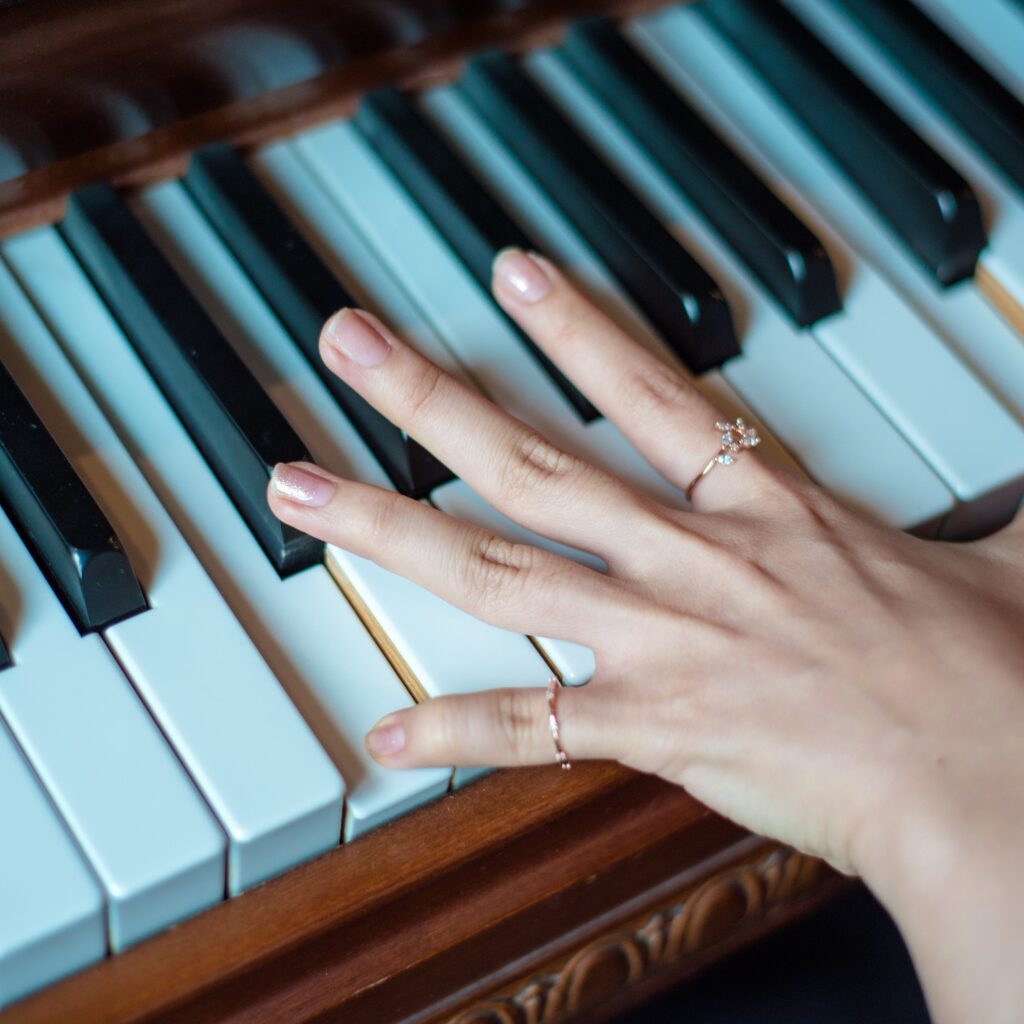If you’re wondering “What are easy piano songs for beginners?”, you’ve come to the right place. Starting your musical journey can be intimidating, but choosing the right beginner songs is the key to gaining confidence and enjoying the learning process.

Table of Contents
Learning Easy Piano Songs – Guide
Here’s how to learn easy songs on piano…
Step 1: Choosing the Right Instrument
Before venturing into easy piano songs, having the right instrument for practice is crucial. While it may be tempting to choose an instrument based on its aesthetics, consider the following factors:
Type of Instrument: Decide between an acoustic piano and a digital keyboard. Acoustic pianos offer a rich sound but are bulky and expensive. Digital keyboards are portable and often come with added features like different sound settings.
Budget: Prices can range widely. Keyboards can start at a couple of hundred dollars, while acoustic pianos can run into thousands. Choose one that fits your budget.
Space: Ensure you have enough space at home to accommodate the instrument.
Test Play: If possible, play the instrument before purchase to get a feel for its sound and touch.
Step 2: Understanding Basic Piano Keys
The heart of playing easy piano songs lies in understanding the keys. A standard piano has 88 keys which include both white and black keys. Here’s how to familiarize yourself:
Identify the White Keys: Starting from the left, the white keys are named A to G, and this pattern repeats as you move to the right.
Find Middle C: This is an important reference point. It is the white key immediately to the left of a group of two black keys near the center of the keyboard.
Black Keys: These are the sharps and flats and are named after the white key they are closest to (e.g., C sharp is the black key to the right of C).
Step 3: Learning Basic Chords
Understanding chords is pivotal to your journey in mastering easy piano songs for beginners. Chords are simply a group of notes played together, and they give depth and mood to a song. Here’s how to navigate the world of chords.
Major Chords
Identifying Major Chords: The major chords you should start with are C, F, and G. These chords have a happy and uplifting sound and are frequently used in popular and beginner-friendly music.
The Structure: Major chords are usually formed with the root note, the major third, and the perfect fifth. For example, for a C major chord, C is the root, E is the major third, and G is the perfect fifth.
Finger Placement
For C Major: Place your thumb (finger 1) on the C key, your middle finger (finger 3) on the E key, and your pinky (finger 5) on the G key. Press all three keys simultaneously. This is your C major chord.
For F Major: Similarly, place your thumb on F, your middle finger on A, and your pinky on C. Press them together to form the F major chord.
For G Major: Your thumb goes on G, your middle finger on B, and your pinky on D. Press these keys at the same time to get the G major chord.
Hand Position: Maintain a relaxed hand posture. Your fingers should be slightly curved, allowing for easy movement across keys.
Chord Progressions
What Are They?: A chord progression is a series of chords played in a sequence. They are the backbone of a song and dictate its emotional tone.
Simple Progressions: As a beginner, you can start with the progression from C major to F major, then to G major, and back to C major. This is often notated as I-IV-V-I, indicating the positions of these chords in a key. In the key of C major, C is the I, F is the IV, and G is the V.
Practice: After forming each chord, try moving smoothly from one to the next. This will help you get used to the finger transitions required for more complex songs later on.
Incorporate Rhythm: Once you’re comfortable moving between chords, try adding a basic rhythm by tapping your foot or using a metronome. This can make your practice sessions more engaging and musically satisfying.
Step 4: Master Basic Finger Techniques
Proper finger positioning is key to smooth playing.
Finger Numbers: Your thumb is 1, and the numbers go up to your little finger which is 5.
Hand Position: Keep your hands relaxed and fingers slightly curved, as if you’re holding a small ball.
Scales: Practice C major scale to get accustomed to moving your fingers across keys.
Step 5: Explore Easy Piano Songs
Finally, here are easy piano songs for beginners:
“Twinkle Twinkle Little Star”: This song mainly uses the white keys and is excellent for practicing basic finger movements.
“Mary Had a Little Lamb”: Great for practicing simple note sequences and using different fingers.
“Jingle Bells”: A seasonal favorite that helps you get used to chord changes.
“Happy Birthday”: A universally recognized tune that can be played with just a few chords.
Step 6: Practice Regularly
Make a schedule and stick to it. Even 20 minutes a day can make a big difference over time. The goal is to build muscle memory and improve your confidence.
Step 7: Review and Adjust
Self-Evaluation: Take a few minutes at the end of your practice to assess how you did. Were you able to play the chords smoothly? Did you maintain proper finger positioning?
Seek Feedback: If possible, have a knowledgeable friend or teacher listen to your playing and provide feedback. Use this input to adjust your practice routine.
For more articles on piano questions, click here: Piano Questions: Your Ultimate Guide to Understanding All About Pianos
Conclusion: What Are Easy Piano Songs for Beginners?
Finding easy piano songs for beginners is the first step towards becoming proficient at the piano. By following these steps, you will not only find the journey less daunting but also incredibly rewarding.